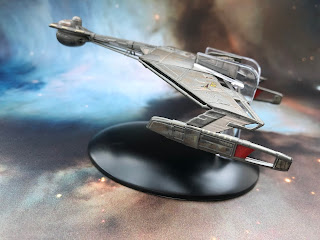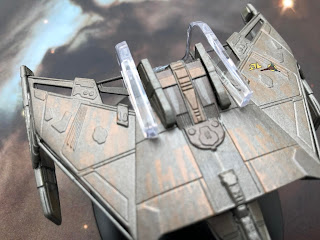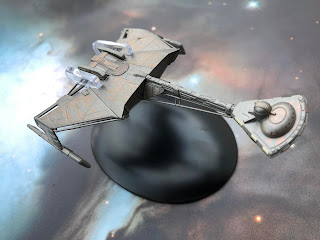Glimpsed on a computer screen, the SS Contestoga made a big impact.
Not in regards to its planetside landing since it was stripped down to create the colony of Terra Nova but because it was a design that wasn't clearly seen for long and indicates an early choice of direction for Earth-produced starships.
The Conestoga is a workhorse designed with one purpose - to transport colonists and then support them during their initial years establishing a base. Surprisingly it's not an ugly, chunky freighter design simply blocked out but instead has smoother lines alongside some familiar Starfleet/Earth technology that also continues to add to the lineage that includes the NX-01 and later editions.
I love the design here and there's some serious detail replicated in this bonus edition and that starts right at the front end. The nose of the Conestoga is filled with antennae that plunges back into the head of the starship. The minutiae of the aerials might be lost into the plastic but you can see the structure of these items on both sides.
Over those aerials is the bridge section to the ship. The model manages to distinguish the command deck and even includes horizontal strengthening bars across the observation ports. Then back from this the way in which Eaglemoss have reproduced the Conestoga relays the simplistic construction with the panelling lines distinct across the surface. In fact if you look from the centre section onto the tops of the elliptical pods the panels are of differing heights although to make them a bit more haphazardly placed would have added to the less "professional" finish.
Over those aerials is the bridge section to the ship. The model manages to distinguish the command deck and even includes horizontal strengthening bars across the observation ports. Then back from this the way in which Eaglemoss have reproduced the Conestoga relays the simplistic construction with the panelling lines distinct across the surface. In fact if you look from the centre section onto the tops of the elliptical pods the panels are of differing heights although to make them a bit more haphazardly placed would have added to the less "professional" finish.
 Saying that, the burnt orange cargo doors on the top of the ship do show irregular patterns of wear with the silver of the hull showing through the top coat. I definitely approve of the way in which this has been completed although the wear only on the doors could have been expanded across the rest of the metalwork.
Saying that, the burnt orange cargo doors on the top of the ship do show irregular patterns of wear with the silver of the hull showing through the top coat. I definitely approve of the way in which this has been completed although the wear only on the doors could have been expanded across the rest of the metalwork.Those worn sections show up again in the forward sections of the elliptical shape of the ship and either side of the command block.
Some of the finer details to pick out are really distinctive to the Conestoga and again illuminate the heritage of Earth ships. To the side of the bridge and also dead centre to the rear there are two familiar deflector dishes that wouldn't be too out of place on the nose of the USS Enterprise NCC-1701 and on the curved sides of the ship are the United Earth emblem and name of the craft again placing this firmly as a pre-Federation creation.
Now to the back there is a significant propulsion unit with four large and four smaller additional exhausts. Like the metal hull, these eight elements show no wear but are another part which reflects other Earth craft, in this case the back end of the OV-165 and the SS Emmette.
Now to the back there is a significant propulsion unit with four large and four smaller additional exhausts. Like the metal hull, these eight elements show no wear but are another part which reflects other Earth craft, in this case the back end of the OV-165 and the SS Emmette.
 Even at this size, the Conestoga fizzles with the energy of that pioneering spirit given its bulky, basic form and those ret-conned warp engines. Irritatingly the warp engines on this one are the only thing that really narked me off because they aren't level with the port nacelle jutting upwards at the tail end and therefore not parallel with its starboard counterpart.
Even at this size, the Conestoga fizzles with the energy of that pioneering spirit given its bulky, basic form and those ret-conned warp engines. Irritatingly the warp engines on this one are the only thing that really narked me off because they aren't level with the port nacelle jutting upwards at the tail end and therefore not parallel with its starboard counterpart.
The pointed bussard collectors, grilles and rear plating does make up for the kink mind, with the collectors in translucent red but the warp grilles on the insides of the tubes painted in blue and from what I can tell these were formed as a tube rather than two halves stuck together - unless those joins really are that well hidden!
The split for the metal to plastic runs along the mid-line of the Conestoga just under the engine pylons and from the back you can see where the curved underside meets the top. The light and dark grey panelling continues here as well as the worn effect on the orange/brown hatches. One significant point to take in is the designation of "1" and "2" on the belly of the Conestoga denoting either shuttlebays or cargo doors - I'm thinking the former.
Stand placement is pretty standard(!) with the clip closing around the pylons and suspending the ship mid-flight.
Stand placement is pretty standard(!) with the clip closing around the pylons and suspending the ship mid-flight.
 The bonus issue magazine somehow makes the Conestoga look newer than the model unusually. It's also incredibly brief when it comes to the background of the ship. Ok, this was a flitting screen CG but it was at the core of the episode and along with the single paragraph of info, the plan views aren't labelled with anything nor are there any additional episode anecdotes in the LCARS callouts.
The bonus issue magazine somehow makes the Conestoga look newer than the model unusually. It's also incredibly brief when it comes to the background of the ship. Ok, this was a flitting screen CG but it was at the core of the episode and along with the single paragraph of info, the plan views aren't labelled with anything nor are there any additional episode anecdotes in the LCARS callouts.There is, following this disappointing feature, a decent six page read on the missing years of Star Trek's fictional universe history from the point where it splits from "our" timeline in the 1990's and the Eugenics Wars which saw the rise to power of one Khan Noonien Singh. For six pages this piece fairly extensively covers events from that time through to the beginning of Enterprise.
Finally there's word from John Eaves on the designing of the ship which was second to the creation of the Terra Nova colony and the buildings that would have been deconstructed from the body of the Conestoga when it arrived at its destination. This piece does help to appreciate the form of the ship more as its look included the necessity to become modular and also be shown as a ship that had been requisitioned with warp technology specifically for its mission.
Alongside it we also have the Klingon D4 Concept that was planned but never used for the Enterprise series.
The Conestoga at least made it to the screen but sadly we were never given the opportunity to be awestruck by one of the more striking Klingon designs in the franchise.
The concept issues have been the ones to collect in my opinion, giving us an extra peep behind the curtains at a Star Trek that might have been and bringing something to fans that we would never have expected. Certainly here there's a ship that I think the producers should be kicking themselves silly we never saw in Enterprise.

The Conestoga at least made it to the screen but sadly we were never given the opportunity to be awestruck by one of the more striking Klingon designs in the franchise.
The concept issues have been the ones to collect in my opinion, giving us an extra peep behind the curtains at a Star Trek that might have been and bringing something to fans that we would never have expected. Certainly here there's a ship that I think the producers should be kicking themselves silly we never saw in Enterprise.

Overall it has the familiar "D" series shape consistent with both the D7 and the movie variant, the K'Tinga Class yet there's that clever retro feel to the model that steps it back a good century and cues it up against that 22nd Century Bird of Prey.
She's an absolute stunner out of the box with that slight green-tint paintwork azteced with a familiar spiked Klingon pattern that glistens bronze in the light. The two colours are right across the D4 and at points the bronzing helps to highlight sections of the hull and adds depth to the visual experience of the ship. Look especially to the head piece and compare the intricate dark grey details on the front to those on the magazine cover - it's a great side by side and not the biggest area to have to try and replicate it on!
She's an absolute stunner out of the box with that slight green-tint paintwork azteced with a familiar spiked Klingon pattern that glistens bronze in the light. The two colours are right across the D4 and at points the bronzing helps to highlight sections of the hull and adds depth to the visual experience of the ship. Look especially to the head piece and compare the intricate dark grey details on the front to those on the magazine cover - it's a great side by side and not the biggest area to have to try and replicate it on!
One grumble to kick off with early is that the neck and command module are 100% plastic and glued onto the metal body. While it reduces front end weight on the rear clip-on stand position, it's quite bendy and is easily the weakest point of the D4. That's not a detraction from the detail with that superb paint-job and the distinct tower structure for the bridge all well molded as is the underside, recessed photon torpedo launcher staring forward from the bulbous nose.The neck parallels the Bird of Prey from this era and also the D5 with thick cabling extending from the forward module back to the engineering hull. The detail on the cables is minimal and actually would it be needed in space? Does the neck need the support? Who cares because it looks kind of cool at least.
The secondary hull shape is once more a familiar element ret-conned more from the higher detailed K'Tinga rather than the block basic D7 from The Original Series. The panel lines are clear and to the port side we have the Klingon tri-pointed emblem, the only decal on the ship.
The secondary hull shape is once more a familiar element ret-conned more from the higher detailed K'Tinga rather than the block basic D7 from The Original Series. The panel lines are clear and to the port side we have the Klingon tri-pointed emblem, the only decal on the ship.
 The colours just work so damn well on this one; it looks stunning and the steps "back" such as the use of negative space in the wings and the cables to "strengthen" the starship make it firmly grounded in the Enterprise time frame. Perhaps it was just too familiar to use for the show as it is virtually a carbon copy yet Eaglemoss have created something in this concept model that might rival the editions of the ship that made it into the regular line.
The colours just work so damn well on this one; it looks stunning and the steps "back" such as the use of negative space in the wings and the cables to "strengthen" the starship make it firmly grounded in the Enterprise time frame. Perhaps it was just too familiar to use for the show as it is virtually a carbon copy yet Eaglemoss have created something in this concept model that might rival the editions of the ship that made it into the regular line.
I love the crisp painting of the impulse engines along the back of the raised engine module to the back, there's even a small docking port that I only noticed after a few look-overs. Eaglemoss have pulled out a winner that looks amazing from all angles here and I can't see that they're put a foot wrong. Ok, I have to say that since there's nothing to compare it to on screen and this oozes quality and believability all the way.
Final great point here - those warp engines which echo the D5 and the Raptor with the use of negative space to the back. But that's not all that's worth a second look because the engines look used with blotchy paintwork making the units seem overworked and under maintained or could it just be exhaust gases staining the paintwork?
Building the secondary hull as a solid piece has worked to Eaglemoss' advantage too because all the extraneous elements such as the cables, the engines and the neck and command module have all been "bolted" on to complete the effect. Love it, love it, LOVE IT.
The magazine only disappoints on the first double page since it's CG image of the ship n all it's dark, Klingon concept glory - and then the rest of the whole issues is given over to the master of Klingon shipwork, John Eaves. There's a ton of starship designs and sketches here along with Eaves' words on how he came up with the look of the fleet from The Way of the Warrior through to the prequel craft of Enterprise (plus the wingtip gun for the closeup in Star Trek V some years earlier).
Enthralling, entertaining and essential reading for any fan of the Empire, there's a lot to take in from the Negh'Var to the Klingon scoutship and all points and sizes in between, one of the best pieces to accompany any starship from the whole of the collection thus far.
These two bonus editions are more impressive than a lot of the more recent issues of the regular line. The SS Conestoga and the D4 are once again ships that show off how far CG had come by the time of Enterprise against the model-reliant years of Deep Space Nine and The Next Generation. The detail on every inch of both ships blows your mind and they absolutely look the part from every conceivable angle and distance.
These feel used, worked and serviceable and are paired with magazines that function as excellent support material to both vessels. While the initial concept of both might not excite, once AGAIN it's the underlings from Star Trek's oft-maligned prequel that are the real stars of the show.
Read all our other reviews of The Official Starships Collection from issue ONE here.
Enjoyed this article? Why not like and share to spread the word!
Like our page on Facebook
Follow us on Twitter
Find us on Tumblr






































